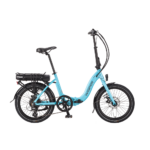Can I tap the forum's knowledge of Bike dynamo lighting with LED's ?
I know it sounds superfluous on a Pedelec forum where there's already a nice big battery onboard, but I'm thinking about my human powered bikes.
Have the advances in LED lighting and the much lower consumption made dynamos less attractive ? I know they'd advanced to the point where they could keep the rear light temporarily on while stopped at traffic lights, but I believe the front light went out.
Are there any good ( and fairly cheap ! ) central battery LED light systems for bikes that use a 12v rechargeable battery with a good (many hours) capacity between recharging ?
) central battery LED light systems for bikes that use a 12v rechargeable battery with a good (many hours) capacity between recharging ?
I know it sounds superfluous on a Pedelec forum where there's already a nice big battery onboard, but I'm thinking about my human powered bikes.
Have the advances in LED lighting and the much lower consumption made dynamos less attractive ? I know they'd advanced to the point where they could keep the rear light temporarily on while stopped at traffic lights, but I believe the front light went out.
Are there any good ( and fairly cheap !







